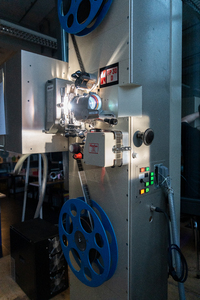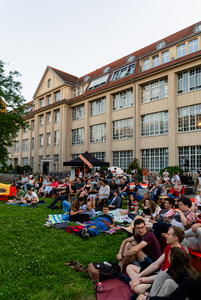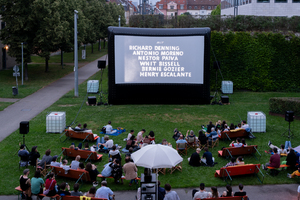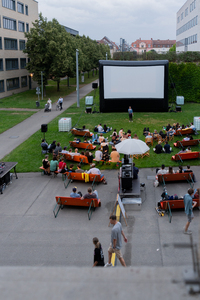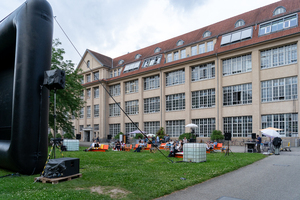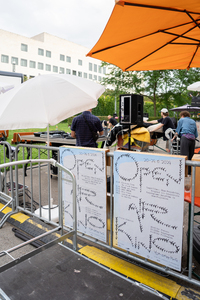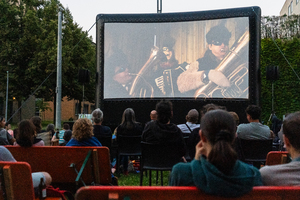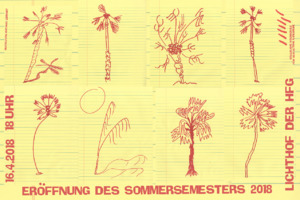Werk
Alle Inhalte mit Metadaten des Vokabulars "Werk". Sie sehen nur Inhalte, für die Sie berechtigt sind.
1949 Inhalte
- Seite 1 von 163
Open Air Kino
- Titel
- Open Air Kino
- Schlagworte
- Datierung
- 20.06.2024 - 24.06.2024
- Ort: Institution
- Ort
- Grüne Wiese
- Stadt
- Land
- Titel
- Open Air Kino
- Urheberrechtshinweis
- © Staatliche Hochschule für Gestaltung Karlsruhe; Matylda Eaton
- Rechtsschutz/Lizenz
- Freigabe Nutzung HfG
- Medienersteller/in
- Medien-Beschreibung
- Dokumentationd des Open Air Kinos des Blauen Salon im Juni 2024
- Importiert am
- 26.08.2024
- Übergeordnete Sets
- 1
Open Air Kino
- Titel
- Open Air Kino
- Schlagworte
- Datierung
- 20.06.2024 - 24.06.2024
- Ort: Institution
- Ort
- Grüne Wiese
- Stadt
- Land
- Titel
- Open Air Kino
- Urheberrechtshinweis
- © Staatliche Hochschule für Gestaltung Karlsruhe; Matylda Eaton
- Rechtsschutz/Lizenz
- Freigabe Nutzung HfG
- Medienersteller/in
- Medien-Beschreibung
- Dokumentationd des Open Air Kinos des Blauen Salon im Juni 2024
- Importiert am
- 26.08.2024
- Übergeordnete Sets
- 1
Open Air Kino
- Titel
- Open Air Kino
- Schlagworte
- Datierung
- 20.06.2024 - 24.06.2024
- Ort: Institution
- Ort
- Grüne Wiese
- Stadt
- Land
- Titel
- Open Air Kino
- Urheberrechtshinweis
- © Staatliche Hochschule für Gestaltung Karlsruhe; Matylda Eaton
- Rechtsschutz/Lizenz
- Freigabe Nutzung HfG
- Medienersteller/in
- Medien-Beschreibung
- Dokumentationd des Open Air Kinos des Blauen Salon im Juni 2024
- Importiert am
- 26.08.2024
- Übergeordnete Sets
- 1
Open Air Kino
- Titel
- Open Air Kino
- Schlagworte
- Datierung
- 20.06.2024 - 24.06.2024
- Ort: Institution
- Ort
- Grüne Wiese
- Stadt
- Land
- Titel
- Open Air Kino
- Urheberrechtshinweis
- © Staatliche Hochschule für Gestaltung Karlsruhe; Matylda Eaton
- Rechtsschutz/Lizenz
- Freigabe Nutzung HfG
- Medienersteller/in
- Medien-Beschreibung
- Dokumentationd des Open Air Kinos des Blauen Salon im Juni 2024
- Importiert am
- 26.08.2024
- Übergeordnete Sets
- 1
Open Air Kino
- Titel
- Open Air Kino
- Schlagworte
- Datierung
- 20.06.2024 - 24.06.2024
- Ort: Institution
- Ort
- Grüne Wiese
- Stadt
- Land
- Titel
- Open Air Kino
- Urheberrechtshinweis
- © Staatliche Hochschule für Gestaltung Karlsruhe; Matylda Eaton
- Rechtsschutz/Lizenz
- Freigabe Nutzung HfG
- Medienersteller/in
- Medien-Beschreibung
- Dokumentationd des Open Air Kinos des Blauen Salon im Juni 2024
- Importiert am
- 26.08.2024
- Übergeordnete Sets
- 1
Open Air Kino
- Titel
- Open Air Kino
- Schlagworte
- Datierung
- 20.06.2024 - 24.06.2024
- Ort: Institution
- Ort
- Grüne Wiese
- Stadt
- Land
- Titel
- Open Air Kino
- Urheberrechtshinweis
- © Staatliche Hochschule für Gestaltung Karlsruhe; Matylda Eaton
- Rechtsschutz/Lizenz
- Freigabe Nutzung HfG
- Medienersteller/in
- Medien-Beschreibung
- Dokumentationd des Open Air Kinos des Blauen Salon im Juni 2024
- Importiert am
- 26.08.2024
- Übergeordnete Sets
- 1
Open Air Kino
- Titel
- Open Air Kino
- Schlagworte
- Datierung
- 20.06.2024 - 24.06.2024
- Ort: Institution
- Ort
- Grüne Wiese
- Stadt
- Land
- Titel
- Open Air Kino
- Urheberrechtshinweis
- © Staatliche Hochschule für Gestaltung Karlsruhe; Matylda Eaton
- Rechtsschutz/Lizenz
- Freigabe Nutzung HfG
- Medienersteller/in
- Medien-Beschreibung
- Dokumentationd des Open Air Kinos des Blauen Salon im Juni 2024
- Importiert am
- 26.08.2024
- Übergeordnete Sets
- 1
Open Air Kino
- Titel
- Open Air Kino
- Schlagworte
- Datierung
- 20.06.2024 - 24.06.2024
- Ort: Institution
- Ort
- Grüne Wiese
- Stadt
- Land
- Titel
- Open Air Kino
- Urheberrechtshinweis
- © Staatliche Hochschule für Gestaltung Karlsruhe; Matylda Eaton
- Rechtsschutz/Lizenz
- Freigabe Nutzung HfG
- Medienersteller/in
- Medien-Beschreibung
- Dokumentationd des Open Air Kinos des Blauen Salon im Juni 2024
- Importiert am
- 26.08.2024
- Übergeordnete Sets
- 1
Open Air Kino
- Titel
- Open Air Kino
- Schlagworte
- Datierung
- 20.06.2024 - 24.06.2024
- Ort: Institution
- Ort
- Grüne Wiese
- Stadt
- Land
- Titel
- Open Air Kino
- Urheberrechtshinweis
- © Staatliche Hochschule für Gestaltung Karlsruhe; Matylda Eaton
- Rechtsschutz/Lizenz
- Freigabe Nutzung HfG
- Medienersteller/in
- Medien-Beschreibung
- Dokumentationd des Open Air Kinos des Blauen Salon im Juni 2024
- Importiert am
- 26.08.2024
- Übergeordnete Sets
- 1
Open Air Kino
- Titel
- Open Air Kino
- Schlagworte
- Datierung
- 20.06.2024 - 24.06.2024
- Ort: Institution
- Ort
- Grüne Wiese
- Stadt
- Land
- Titel
- Open Air Kino
- Urheberrechtshinweis
- © Staatliche Hochschule für Gestaltung Karlsruhe; Matylda Eaton
- Rechtsschutz/Lizenz
- Freigabe Nutzung HfG
- Medienersteller/in
- Medien-Beschreibung
- Dokumentationd des Open Air Kinos des Blauen Salon im Juni 2024
- Importiert am
- 26.08.2024
- Übergeordnete Sets
- 1
Open Air Kino
- Titel
- Open Air Kino
- Schlagworte
- Datierung
- 20.06.2024 - 24.06.2024
- Ort: Institution
- Ort
- Grüne Wiese
- Stadt
- Land
- Titel
- Open Air Kino
- Urheberrechtshinweis
- © Staatliche Hochschule für Gestaltung Karlsruhe; Matylda Eaton
- Rechtsschutz/Lizenz
- Freigabe Nutzung HfG
- Medienersteller/in
- Medien-Beschreibung
- Dokumentationd des Open Air Kinos des Blauen Salon im Juni 2024
- Importiert am
- 26.08.2024
- Übergeordnete Sets
- 1
Onlinebanner zur Semestereröffnung
- Titel
- Onlinebanner zur Semestereröffnung
- Autor/in
- Schlagworte
- Datierung
- 16.04.2018
- Mitwirkende
- Sprache
- Ort
- Lichthof der HfG
- Stadt
- Land
- Titel
- Onlinebanner zur Semestereröffnung
- Urheberrechtshinweis
- Mathias Lempart /HfG
- Importiert am
- 20.04.2018
- Übergeordnete Sets
- 0
